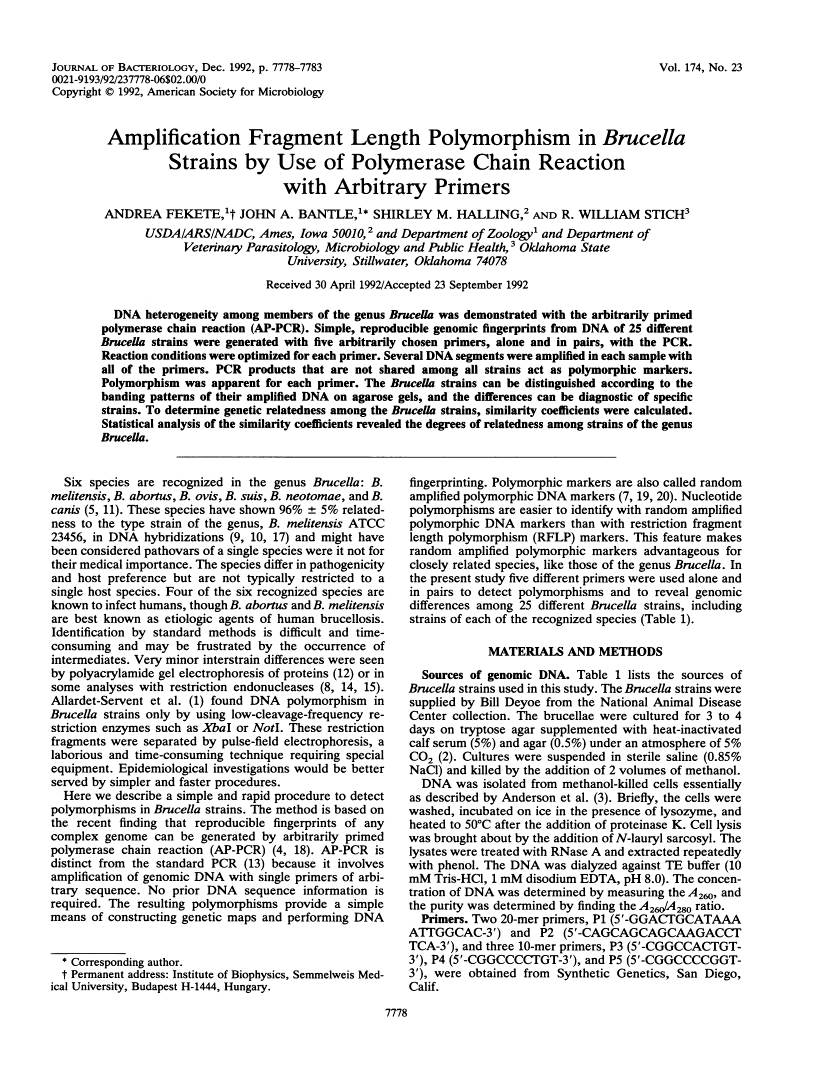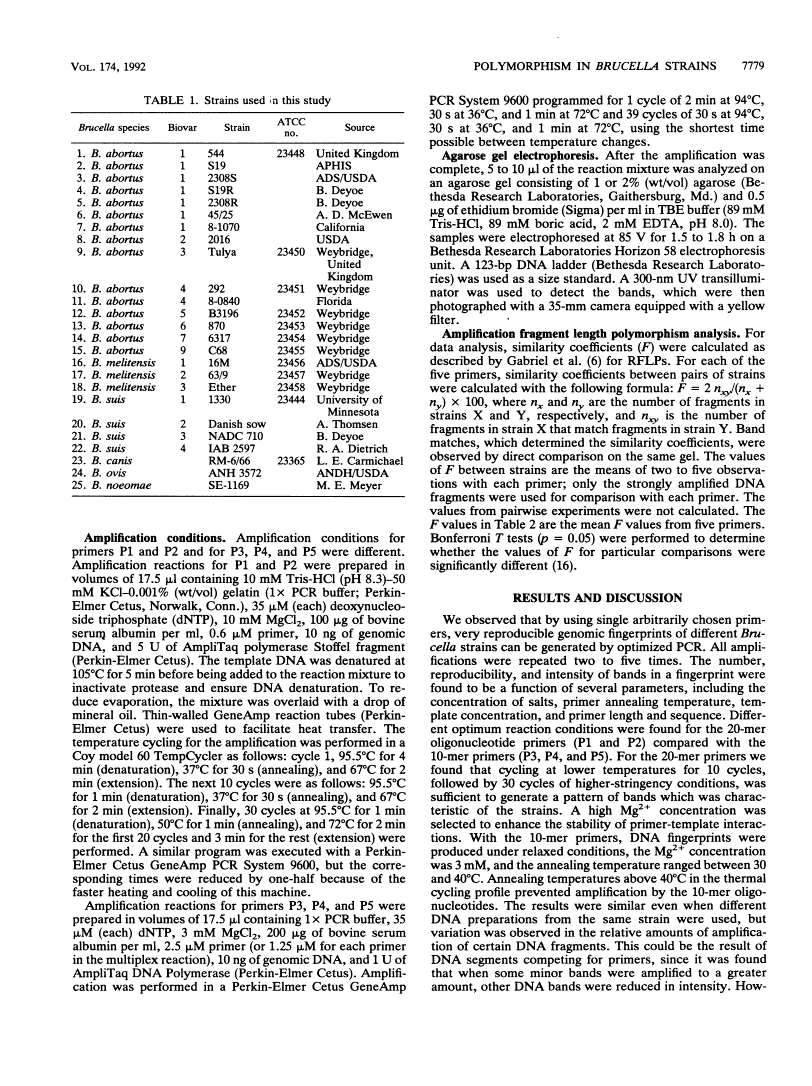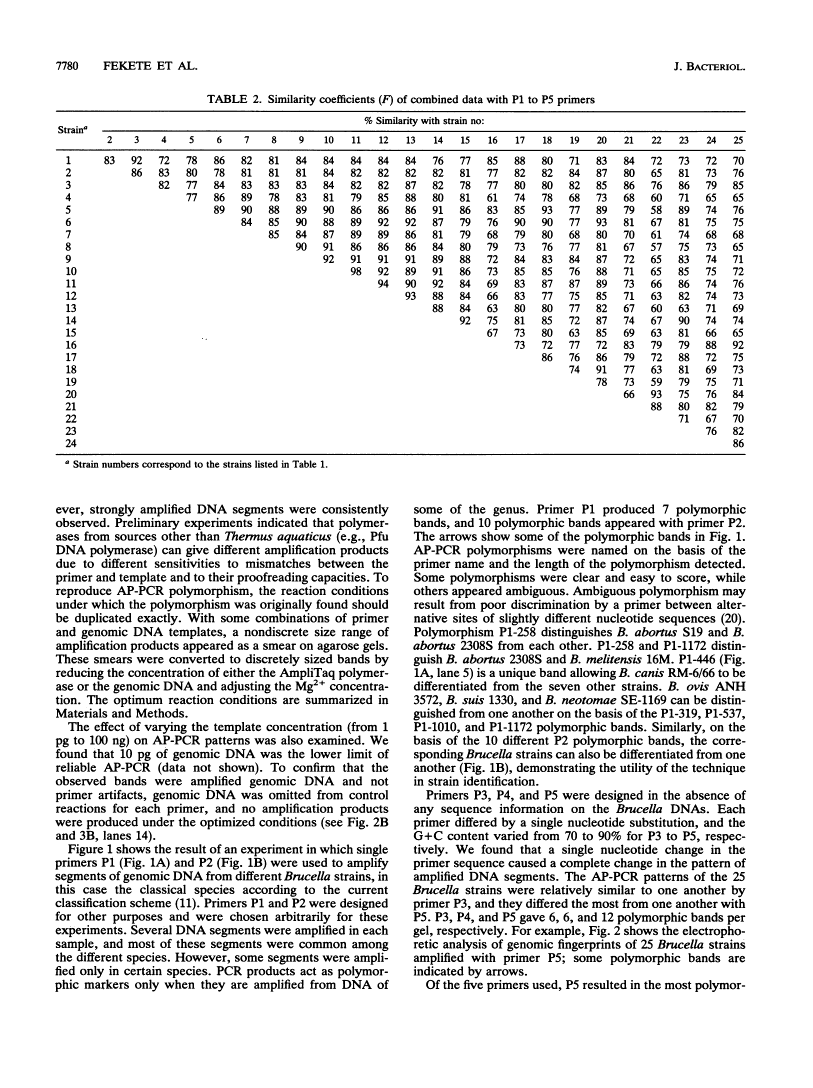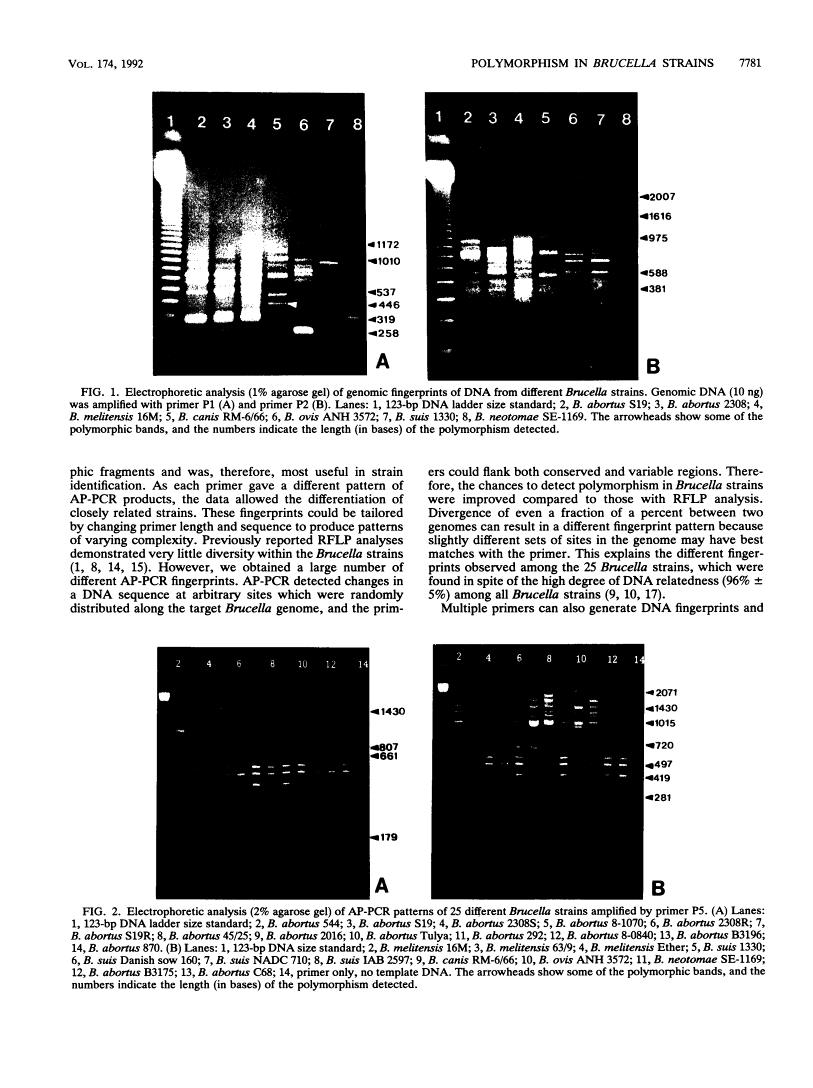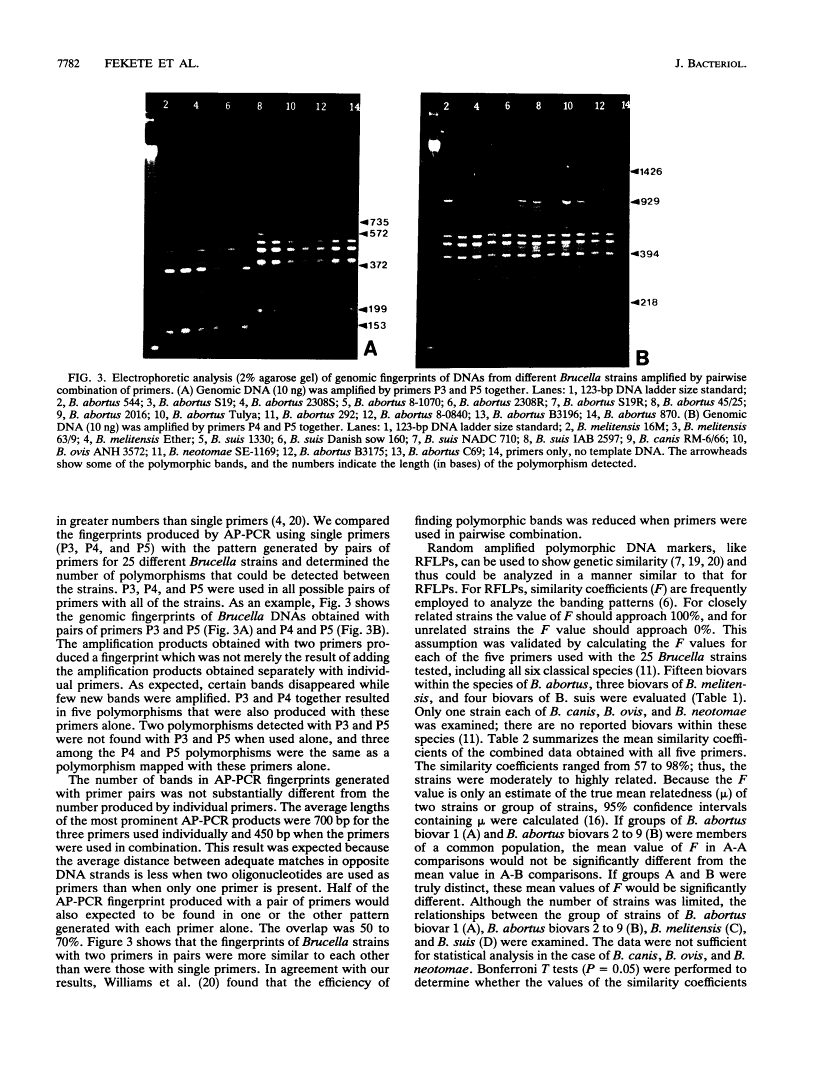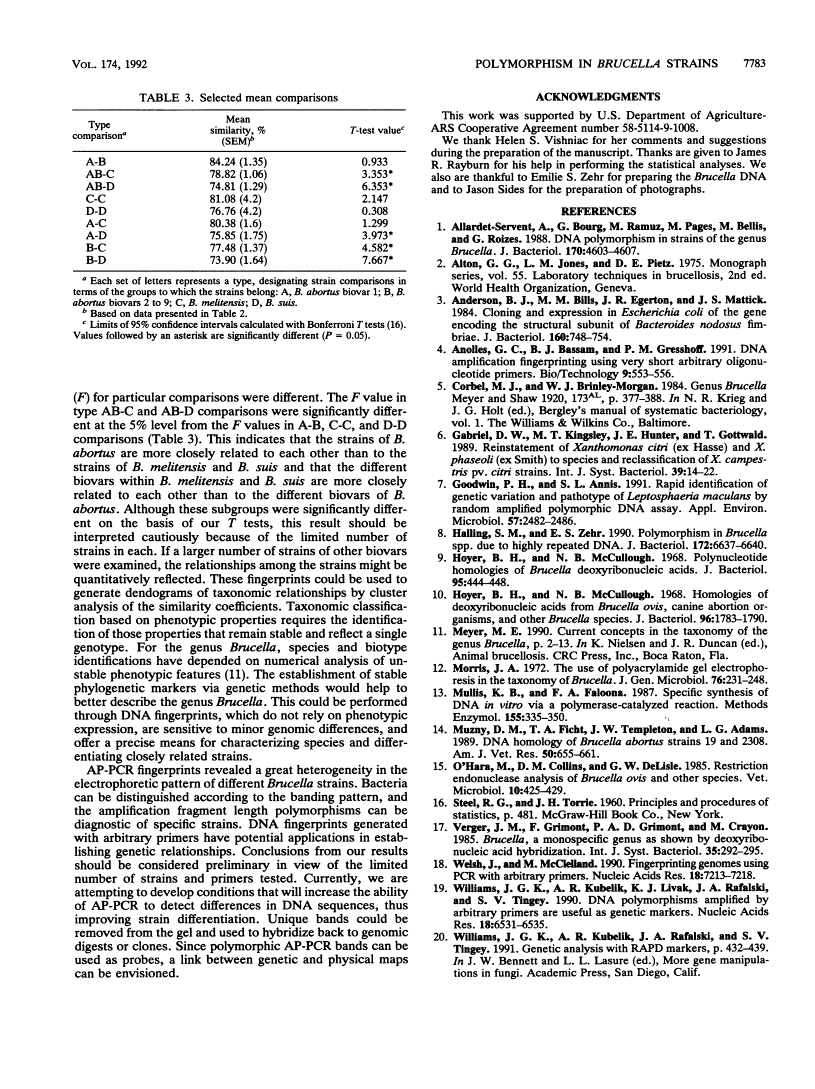Abstract
Free full text

Amplification fragment length polymorphism in Brucella strains by use of polymerase chain reaction with arbitrary primers.
Abstract
DNA heterogeneity among members of the genus Brucella was demonstrated with the arbitrarily primed polymerase chain reaction (AP-PCR). Simple, reproducible genomic fingerprints from DNA of 25 different Brucella strains were generated with five arbitrarily chosen primers, alone and in pairs, with the PCR. Reaction conditions were optimized for each primer. Several DNA segments were amplified in each sample with all of the primers. PCR products that are not shared among all strains act as polymorphic markers. Polymorphism was apparent for each primer. The Brucella strains can be distinguished according to the banding patterns of their amplified DNA on agarose gels, and the differences can be diagnostic of specific strains. To determine genetic relatedness among the Brucella strains, similarity coefficients were calculated. Statistical analysis of the similarity coefficients revealed the degrees of relatedness among strains of the genus Brucella.
Full text
Full text is available as a scanned copy of the original print version. Get a printable copy (PDF file) of the complete article (1.6M), or click on a page image below to browse page by page. Links to PubMed are also available for Selected References.
Images in this article
Selected References
These references are in PubMed. This may not be the complete list of references from this article.
- Allardet-Servent A, Bourg G, Ramuz M, Pages M, Bellis M, Roizes G. DNA polymorphism in strains of the genus Brucella. J Bacteriol. 1988 Oct;170(10):4603–4607. [Europe PMC free article] [Abstract] [Google Scholar]
- Anderson BJ, Bills MM, Egerton JR, Mattick JS. Cloning and expression in Escherichia coli of the gene encoding the structural subunit of Bacteroides nodosus fimbriae. J Bacteriol. 1984 Nov;160(2):748–754. [Europe PMC free article] [Abstract] [Google Scholar]
- Caetano-Anollés G, Bassam BJ, Gresshoff PM. DNA amplification fingerprinting using very short arbitrary oligonucleotide primers. Biotechnology (N Y) 1991 Jun;9(6):553–557. [Abstract] [Google Scholar]
- Goodwin PH, Annis SL. Rapid identification of genetic variation and pathotype of Leptosphaeria maculans by random amplified polymorphic DNA assay. Appl Environ Microbiol. 1991 Sep;57(9):2482–2486. [Europe PMC free article] [Abstract] [Google Scholar]
- Halling SM, Zehr ES. Polymorphism in Brucella spp. due to highly repeated DNA. J Bacteriol. 1990 Dec;172(12):6637–6640. [Europe PMC free article] [Abstract] [Google Scholar]
- Hoyer BH, McCullough NB. Polynucleotide homologies of Brucella deoxyribonucleic acids. J Bacteriol. 1968 Feb;95(2):444–448. [Europe PMC free article] [Abstract] [Google Scholar]
- Hoyer BH, McCullough NB. Homologies of deoxyribonucleic acids from Brucella ovis, canine abortion organisms, and other Brucella species. J Bacteriol. 1968 Nov;96(5):1783–1790. [Europe PMC free article] [Abstract] [Google Scholar]
- Morris JA. The use of polyacrylamide gel electrophoresis in taxonomy of Brucella. J Gen Microbiol. 1973 May;76(1):231–237. [Abstract] [Google Scholar]
- Mullis KB, Faloona FA. Specific synthesis of DNA in vitro via a polymerase-catalyzed chain reaction. Methods Enzymol. 1987;155:335–350. [Abstract] [Google Scholar]
- Muzny DM, Ficht TA, Templeton JW, Adams LG. DNA homology of Brucella abortus strains 19 and 2308. Am J Vet Res. 1989 May;50(5):655–661. [Abstract] [Google Scholar]
- O'Hara MJ, Collins DM, de Lisle GW. Restriction endonuclease analysis of Brucella ovis and other Brucella species. Vet Microbiol. 1985 Aug;10(5):425–429. [Abstract] [Google Scholar]
- Welsh J, McClelland M. Fingerprinting genomes using PCR with arbitrary primers. Nucleic Acids Res. 1990 Dec 25;18(24):7213–7218. [Europe PMC free article] [Abstract] [Google Scholar]
- Williams JG, Kubelik AR, Livak KJ, Rafalski JA, Tingey SV. DNA polymorphisms amplified by arbitrary primers are useful as genetic markers. Nucleic Acids Res. 1990 Nov 25;18(22):6531–6535. [Europe PMC free article] [Abstract] [Google Scholar]
Associated Data
Articles from Journal of Bacteriology are provided here courtesy of American Society for Microbiology (ASM)
Full text links
Read article at publisher's site: https://doi.org/10.1128/jb.174.23.7778-7783.1992
Read article for free, from open access legal sources, via Unpaywall:
https://europepmc.org/articles/pmc207493?pdf=render
Free to read at jb.asm.org
http://jb.asm.org/cgi/content/abstract/174/23/7778
Free after 4 months at jb.asm.org
http://jb.asm.org/cgi/reprint/174/23/7778
Citations & impact
Impact metrics
Citations of article over time
Smart citations by scite.ai
Explore citation contexts and check if this article has been
supported or disputed.
https://scite.ai/reports/10.1128/jb.174.23.7778-7783.1992
Article citations
A Novel PCR Assay for Detecting Brucella abortus and Brucella melitensis.
Osong Public Health Res Perspect, 8(1):65-70, 28 Feb 2017
Cited by: 6 articles | PMID: 28443226 | PMCID: PMC5402848
Polymerase chain reaction-based assays for the diagnosis of human brucellosis.
Ann Clin Microbiol Antimicrob, 13:31, 01 Aug 2014
Cited by: 23 articles | PMID: 25082566 | PMCID: PMC4236518
Review Free full text in Europe PMC
Specific genomic fingerprints of phosphate solubilizing Pseudomonas strains generated by BOX elements.
Biomed Res Int, 2014:496562, 15 Dec 2014
Cited by: 0 articles | PMID: 25580434 | PMCID: PMC4279365
Feral swine brucellosis in the United States and prospective genomic techniques for disease epidemiology.
Vet Microbiol, 166(1-2):1-10, 15 Mar 2013
Cited by: 20 articles | PMID: 23548760
Review
A review of Brucella infection in marine mammals, with special emphasis on Brucella pinnipedialis in the hooded seal (Cystophora cristata).
Vet Res, 42:93, 05 Aug 2011
Cited by: 63 articles | PMID: 21819589 | PMCID: PMC3161862
Review Free full text in Europe PMC
Go to all (59) article citations
Similar Articles
To arrive at the top five similar articles we use a word-weighted algorithm to compare words from the Title and Abstract of each citation.
IS6501-anchored PCR for the detection and identification of Brucella species and strains.
J Appl Bacteriol, 81(2):154-160, 01 Aug 1996
Cited by: 19 articles | PMID: 8760325
Application of polymerase chain reaction with arbitrary primers to strain identification of Mycoplasma gallisepticum.
Avian Dis, 39(4):729-735, 01 Oct 1995
Cited by: 43 articles | PMID: 8719206
Authentication of the Chinese drug "ku-di-dan" (herba elephantopi) and its substitutes using random-primed polymerase chain reaction (PCR).
Yao Xue Xue Bao, 31(7):543-553, 01 Jan 1996
Cited by: 2 articles | PMID: 9772698
Identification of brucella species and biotypes using polymerase chain reaction-restriction fragment length polymorphism (PCR-RFLP).
Crit Rev Microbiol, 31(4):191-196, 01 Jan 2005
Cited by: 22 articles | PMID: 16417200
Review
